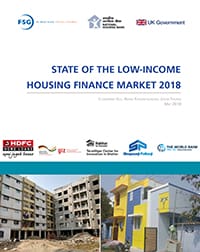An innovative new model pioneered by affordable housing finance companies (AHFCs) has made home ownership attainable for millions of low-income informal sector customers in urban India. There are now 26 such AHFCs with a combined loan portfolio of $4.1+ billion in India, who have financed over 230,000 houses over the last decade. Due to the availability of equity and debt, and potential for geographic expansion, this market is likely to continue to grow rapidly. This report examines the current state of the market and provides recommendations for facilitating greater scale so that even more households can own or improve their homes.
Top Takeaways
- Because many low-income customers in India (earning $230-$770 a month) do not have formal documentation of income, AHFCs developed and proved a field-based, detailed credit assessment and verification process that could reliably assess income, assets, and repayment capability.
- AHFCs have primarily financed independent units (“self-construction”) and homes in small multi-unit buildings built by informal developers. In addition to providing low-priced units for potential homeowners, this activity leads to both employment generation and improvement of rental stock.
- The overall industry shows robust growth, with low NPAs, but banks/larger housing finance companies take over loans from the smaller AHFCs which do the fieldwork to acquire customers, without any compensation to these smaller AHFCs.
- There are opportunities to use housing finance to improve living conditions for households living in slums and for customers approved for the Beneficiary Led Construction scheme of the PMAY. These segments remain unserved by housing finance, despite interest from lending organizations.


